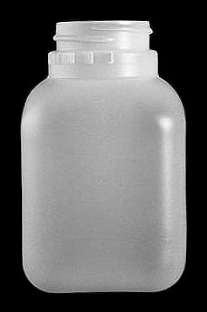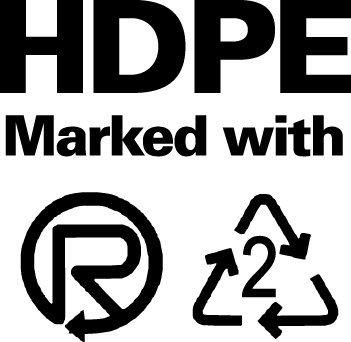Polymer #1: Poly(ethene)
(Also known as polyethylene or PE.)



More polymers: poly(propene), poly(chloroethene), poly(tetrafluoroethene).
Adapted from "Atkins' Molecules" by Peter Atkins
One of the substances that can add to ethene is ethene itself. Poly(ethene) is formed when ethene molecules join together, and the process can continue until the string of linked -CH2-CH2- units has grown to an enormous length - perhaps thousands of units long. When you touch a poly(ethene) article, you can feel the characteristic waxy texture of a hydrocarbon.
Molecular structure of poly(ethene)

In a typical sample of poly(ethene), there are molecules of many different lengths; each chain has many side chainss -ome containing a thousand carbon atoms - where the process of polymerisation has led to attack on an existing polymer chain. All the molecules are tangled together into a microscopic version of a plate of hairy spagetti. Pure poly(ethene) is translusent for the same reason as a slurry of ice is translucent. In the latter, the numerous small ice crystals lie at random orientations to each other, and light passing through is scattered in many different directions. This effect can be so powerful that some look brilliantly white even though they are composed of a colourless, transparent substance: milk is one example, and white house paint, which contains colourless, transparent titanium dioxide, is another. In poly(ethene), domains in which the molecules lie next to each other in an orderly fastion to form crystalline regions alternate with domains in which the chains are jumbled together in disorderly amorphous regions. The crystalline regions lie at random orientations to each other and scatter the light like the cracks and bubbles in ice.
For high-density poly(ethene)s, the reaction conditions (310-160 K and 1-50 atm) are chosen so that the carbon chains are 10000 to 100000 carbon atoms long, are of reasonably similar lengths, and have fewer than one side chain per hundered carbon atoms. The molecules then pack together more effectively, so that the solid is denser, more crystalline, and stiffer than ordinary poly(ethene).
For high-density poly(ethene)s, the reaction conditions (310-160 K and 1-50 atm) are chosen so that the carbon chains are 10000 to 100000 carbon atoms long, are of reasonably similar lengths, and have fewer than one side chain per hundered carbon atoms. The molecules then pack together more effectively, so that the solid is denser, more crystalline, and stiffer than ordinary poly(ethene).
HDPE Container

This procedure can be taken further, to produce ultrahigh-density poly(ethene)s, so called ultrahigh-molecular-weight-polyethylenes (UHMWPEs) with unbranched chains up to 400000 carbon atoms long. The resulting crystalline materials are so tough that they can be used for bullet proof vests, and large sheets have been used in place of ice by skaters on ice-rinks.
Poly(ethene) has excellent electrically insulating properties. These partly stem from the tightness with which the electrons are tapped in their C-C and C-H bonds, so a current cannot flow through the solid. They also reflect the inability of water and ions to penetrate into the oil-like hydrocarbon interior of the solid. Moreover, the molecules are uniformly electrically neutral, with no regions of enhanced positive and negative charge, unlike nylon, for example. As a result, they barely respond to electric fields. In particular, they do not begin to oscillate when they are exposed to an alternating electric field and so do not absorb and dissapate its energy. That is one reason poly(ethene) was so important to the development of radar in the 1940s, for an insulator was needed for cables carrying high-frequency alternating current; it is also why poly(ethene) is still widely used as an insulator.
The hydrocarbon character of the interior of a lump of poly(ethene) makes it a congenial home for other hydrocarbon-like molecules . Thus, poly(ethene) is a solvent for fats, oils, and grease; but, since the polymer molecules are not very mobile, dissolving occurs very slowly, especially in the high-density polymers. Nevertheless, poly(ethene) articles do slowly absorb grease, become stained in it, and lose some of their electrically insulating qualities.
Poly(ethene) has excellent electrically insulating properties. These partly stem from the tightness with which the electrons are tapped in their C-C and C-H bonds, so a current cannot flow through the solid. They also reflect the inability of water and ions to penetrate into the oil-like hydrocarbon interior of the solid. Moreover, the molecules are uniformly electrically neutral, with no regions of enhanced positive and negative charge, unlike nylon, for example. As a result, they barely respond to electric fields. In particular, they do not begin to oscillate when they are exposed to an alternating electric field and so do not absorb and dissapate its energy. That is one reason poly(ethene) was so important to the development of radar in the 1940s, for an insulator was needed for cables carrying high-frequency alternating current; it is also why poly(ethene) is still widely used as an insulator.
The hydrocarbon character of the interior of a lump of poly(ethene) makes it a congenial home for other hydrocarbon-like molecules . Thus, poly(ethene) is a solvent for fats, oils, and grease; but, since the polymer molecules are not very mobile, dissolving occurs very slowly, especially in the high-density polymers. Nevertheless, poly(ethene) articles do slowly absorb grease, become stained in it, and lose some of their electrically insulating qualities.
Recycle

More polymers: poly(propene), poly(chloroethene), poly(tetrafluoroethene).
Adapted from "Atkins' Molecules" by Peter Atkins
3 Comments:
Interesting! What do you want to major in? Mind to exchange links? I won't.. Heheh.. Just let me know if you don't mind. Btw, I got here by Zilko's link.
n.y.,
Sure, will add you to my list. I want to study biochemistry. So similar to what you're doing right now, if I may say so.
Felix
Wow, ur blog is very interesting. Yesterday you posted about mathematics (probability) and now you post about chemistry... :)
A great journal... :D Biochemistry, that's nice. Some of my friends are also interested in that major too... :) You must be very dilligent then... :)
Post a Comment
<< Home